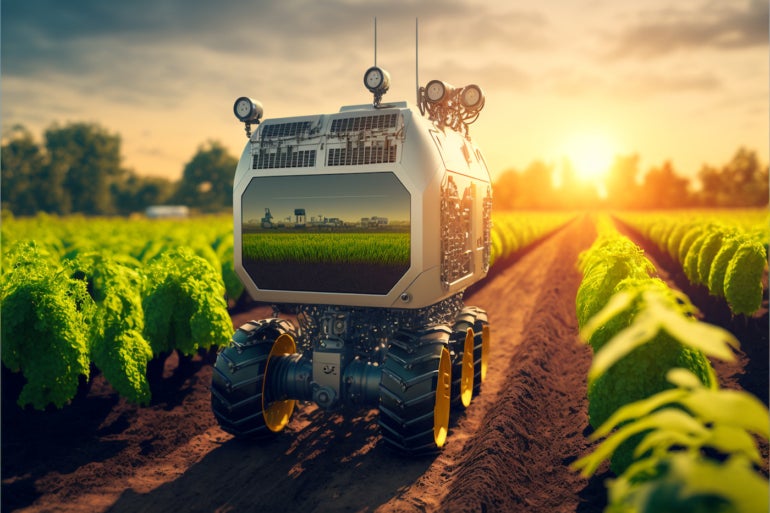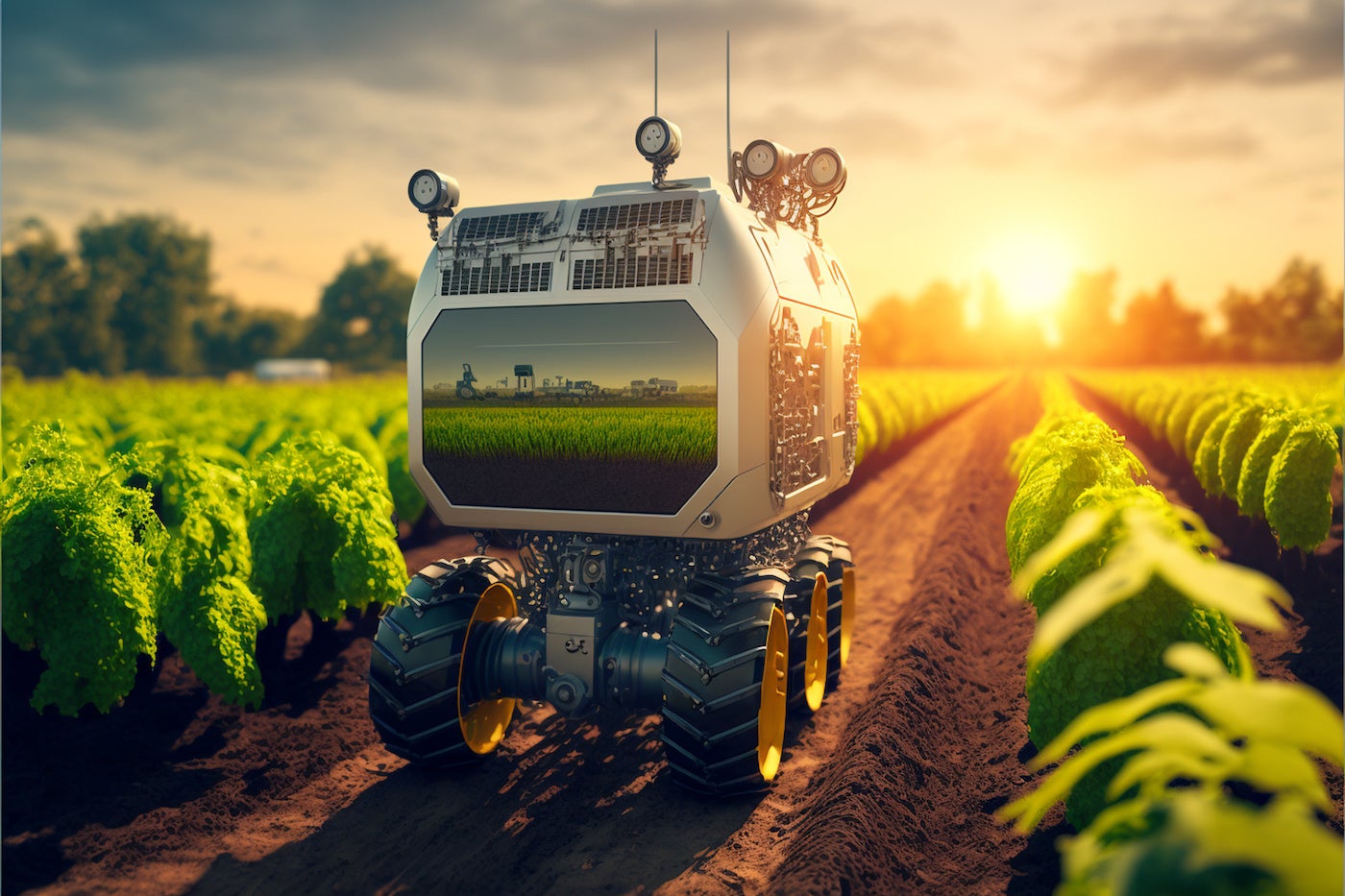
The digital transformation of agriculture is in full swing. Industrial IoT devices, robotics, satellite connectivity, artificial intelligence and cloud-edge platforms are driving the acceleration of the sector.
The Food and Agriculture Organization has warned for years that crop production needs to increase by 60-70% by 2050 to feed the demands of a growing global population. Energy, water and natural resource management, carbon emissions, labor shortages, natural disasters and economic uncertainty are affecting the industry that turns to technology for intelligent solutions.
John May, chairman and CEO of John Deere, took the main stage during the keynote address at CES 2023 to speak on how new tech is helping the sector tackle the challenges of feeding the world. At the event, Deere presented a new fully autonomous IIoT tractor and a new industrial planting technology.
“Our goal is to make our customers more profitable and more productive and help them do the jobs they do more sustainably,” May said. “To do that, we’re leveraging the most advanced technologies.”
John Deere is not alone: Smart industrial agriculture is poised to grow in the next few years. In this report, we will dive into the market and top global companies, their new technologies and the global gaps, challenges and opportunities.
SEE: Hiring Kit: IoT developer (TechRepublic Premium)
Jump to:
Top players and new agritech
Agriculture is one of the largest and most significant industries in the world, with a global value of $2.5 trillion, according to the World Economic Forum. The sector is dominated by companies like Cargill, CNH Industrial, Bayer and John Deere.
Cargill and CNH Industrial: AI-driven platforms and future machines
Cargill has 155 years in business and a presence in 70 countries. Since 2021, the company has been managing RegenConnect, a marketplace that pays farmers for improved soil health and positive environmental outcomes, rewarding them for each metric ton of sequestered carbon.
Additionally, the company is investing in AI-based platforms, such as the Digital Saathi — a platform designed to improve farm management practices — or GalleonTM Broiler Microbiome Intelligence, an AI-platform that helps farmers raise healthier chickens.
CNH Industrial is an American-Italian multinational corporation and recently showcased its new sprayer, tractor and crawler concepts for the future.
CHN’s Case IH’s Patriot 50 series sprayer allows farmworkers to operate inside a cabin with connectivity solutions and integrated spray technology, while the new Holland’s Straddle Tractor Concept as well as the New Holland and FPT Industrial’s TK4 vineyard crawler tractor focus on environmental technology that reduce carbon footprints and costs.
Bayer: Digital farming solutions and technologies
German multinational corporation Bayer, which boosted its agriculture credentials in 2018 with the acquisition of Monsanto for $63 billion, is keen to show off its digital farming solutions.
The company’s Climate FieldView technology helps farmers become data-driven by managing big data generated from sensors, drones, machines and other IIoT devices.
“Remote sensors, satellites and drones can monitor plant health, soil conditions, temperature, nitrogen utilization and much more 24/7,” Bayer said. “That data, coupled with artificial intelligence tools, can help farmers make critical, timely, in-field decisions.”
The Climate FieldView edge-cloud platform gives farmers a picture of their operation. The technology can combine billions of data points, identify disruptions and problems to prevent them before they happen, and increase performance while maximizing land use, energy, water and other resources.
Additionally, Bayer advocates for the use of smart drones, which can provide new perspectives on plant health. Equipped with special imaging technology, these drones can reveal when plants are impacted by various degrees of crop stress, including pests, diseases or droughts.
Field soil sensors have also become increasingly vital for agriculture. Using sensors, producers can monitor detailed soil conditions in real-time, measuring moisture, nutrient levels and other data. The sensors can be paired with irrigation systems to reduce and better manage the use of water by only engaging when and where crops need it.
Bayer also works with tech companies like Microsoft and Google to use their technology expertise and computing power. The partnerships allow Bayer to take on data analytics with cloud-based tools and real-time data analytics.
John Deere: Precision farming and agricultural machinery
Precision farming is another growing trend for the sector. Advanced IIoT farm machines, coupled with GPS and historical and forecast field information, are used to plant the right seeds at the ideal depths, density and location. The automation of these processes not only increases performance but also reduces the use of fuel and carbon footprints.
In the agro-machinery market, John Deere presented at CES 2023 two new technologies: ExactShot and an electric excavator.
Using a sensor, ExactShot registers when each seed is in the process of going into the soil. A robot on the machine will then spray only the amount of fertilizer needed directly onto the seed at the exact moment as it goes into the ground.
Traditionally, starter fertilizers are applied continuously throughout the entire row of seeds. John Deere says that farmers can reduce the amount of starter fertilizer needed during planting by more than 60% using this technology. The company reckons that this new technology could help save over 93 million gallons of starter fertilizer annually while preventing wasted fertilizer from encouraging weed growth or increasing the risk of run-off.
The John Deere electric excavator is designed to reduce fuel, additional operating costs and noise pollution on site, and it’s made to produce zero emissions. John Deere is using the majority stake it has in Kreisel Electric — a company behind battery technology that allows its heavy industrial machinery to operate in full electric mode.
Global gaps and challenges
Floods and historical droughts, pressure to reduce carbon emissions, supply chain disruptions, regional instabilities, the global economic environment, the digital divide, rural connectivity and gaps between the developed and underdeveloped regions are still major obstacles for the industrial agriculture global sector.
While technology innovates to solve many of these issues, for example, reducing energy and water usage with AI analytics and sensors, or using geospatial imagery to increase weather resilience, other problems are proving to be more complex.
Smart industrial agriculture requires reliable, low-latency connectivity, but only 15% of the world is covered by internet networks, and rural areas where agriculture activities concentrate are usually outside coverage areas. Companies like Astrocast — which recently launched onboard a SpaceX Falcon 9 rocket four new nanosatellites to expand their constellation — are working to provide IoT connectivity to rural areas.
Being online is a critical necessity to run agriculture 4.0 systems, but for countries under digital divide gaps and regional development disparities, the problems go far beyond. The State of Food Security and Nutrition report from the FAO reveals that hunger is on the rise in Africa, Asia, Latin America and the Caribbean.
Access to adequate food and healthy diets are also straining the global population. In 2020, about 768 million people were undernourished, and three billion people did not have adequate food and healthy diets. The crisis is linked to climate variability, economic slowdown, conflict and agriculture policies.
On Jan. 12, 2023, FAO Director-General Qu Dongyu attended the UN Food Systems Coordination Hub. At the event, more than 200 participants, including Ministers for Agriculture and high-level national officials, stressed the need to transform agrifood systems, change policies and mindsets, and reimagine business models.
“We can turn the tide through transformation to more efficient, more inclusive, more resilient and more sustainable agrifood systems,” Qu told representatives. “Leveraging finance for agrifood systems transformations is one of the most catalytic actions needed for achieving the SDGs [Sustainable Development Goals] — if we get it right, our agrifood systems can be profitable, equitable, sustainable, healthy and more resilient to shocks.”
Despite the many challenges the industrial agriculture sector faces, companies and innovators are turning the tide with automation and data-driven farms. While work remains ahead, the sector continues to modernize with a cross-industry collaboration approach. From genetics to the space and satellite sector, data and analytics, edge-cloud, IIoT and AI, with environmental awareness at its core, agriculture is shifting to a new era in hopes of feeding the world.
Read more about IIoT with the top five use cases and a brief history.


